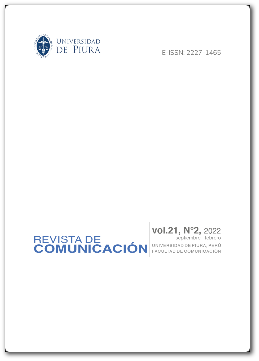Análisis de la capacidad de menores en España para reconocer los contenidos comerciales publicados por influencers.
DOI:
https://doi.org/10.26441/RC21.2-2022-A15Palabras clave:
marketing de influencia, menores, alfabetización publicitaria, pensamiento crítico, redes socialesResumen
Los menores están expuestos a diversos contenidos en su navegación por internet y el presente estudio explora específicamente aquellos creados por influencers en formatos híbridos que mezclan diversos fines, incluidos los comerciales, y que además representan un reto mayor para ser identificados correctamente. Desde la óptica de la alfabetización publicitaria tal y como la articulan Roozendal et al. (2011), la investigación tiene como objetivo identificar qué elementos de las dimensiones conceptuales y actitudinales de esta alfabetización están presentes en el procesamiento que los menores hacen del contenido generado por influencers. Para ello se realizaron 12 grupos de discusión en los que participaron 62 menores de entre 11 y 17 años, de colegio privados, concertados y públicos en España, durante el primer semestre de 2021. Los resultados expresan que en general los menores identifican un vínculo comercial entre marcas e influencers, sin embargo, y especialmente los más pequeños, no son capaces de identificar cuando se les presenta un contenido pagado si este no está señalizado como tal. Los adolescentes, por su parte, asumieron una actitud crítica ante el marketing de influencia a partir de la coherencia y afinidad del producto promocionado y el influencer, así como la trayectoria o profesión del creador de contenido.
Métricas
Citas
An, S., Jin, H. S., & Park, E. H. (2014). Children's advertising literacy for advergames: Perception of the game as advertising. Journal of Advertising, 43(1), 63-72. https://doi.org/10.1080/00913367.2013.795123 DOI: https://doi.org/10.1080/00913367.2013.795123
Boerman, S. C., & Van Reijmersdal, E. A. (2020). Disclosing influencer marketing on YouTube to children: The moderating role of para-social relationship. Frontiers in Psychology, 10, 3042. DOI: https://doi.org/10.3389/fpsyg.2019.03042
Boerman, S. C., Van Reijmersdal, E. A., & Neijens, P. C. (2014). Effects of sponsorship disclosure timing on the processing of sponsored content: A study on the effectiveness of European disclosure regulations. Psychology & Marketing, 31(3), 214-224. DOI: https://doi.org/10.1002/mar.20688
Brown, D., & Hayes, N. (2008). Influencer marketing. Routledge. DOI: https://doi.org/10.4324/9780080557700
Buijzen, M., Van Reijmersdal, E. A., & Owen, L. H. (2010). Introducing the PCMC model: An investigative framework for young people's processing of commercialized media content. Communication Theory, 20(4), 427-450. DOI: https://doi.org/10.1111/j.1468-2885.2010.01370.x
Capriotti, P. (1999). Planificación estratégica de la imagen corporativa. Grupo Planeta (GBS).
Cotter, K. (2019). Playing the visibility game: How digital influencers and algorithms negotiate influence on Instagram. New Media & Society, 21(4), 895-913. https://www.doi.org/10.1177/1461444818815684 DOI: https://doi.org/10.1177/1461444818815684
De Jans, S., & Hudders, L. (2020). Disclosure of vlog advertising targeted to children. Journal of Interactive Marketing, 52, 1-19. DOI: https://doi.org/10.1016/j.intmar.2020.03.003
De Jans, S., Hudders, L., Herrewijn, L., Van Geit, K., & Cauberghe, V. (2019). Serious games going beyond the Call of Duty: Impact of an advertising literacy mini-game platform on adolescents’ motivational outcomes through user experiences and learning outcomes. Cyberpsychology: Journal of Psychosocial Research on Cyberspace, 13(2). DOI: https://doi.org/10.5817/CP2019-2-3
del Mar Pàmies, M., Ryan, G., & Valverde, M. (2016). How intervention can empower children as consumers in dealing with advertising. International Journal of Consumer Studies, 40(5), 601-609. DOI: https://doi.org/10.1111/ijcs.12305
Feijoo, B., Bugueño, S., Sádaba, C., & García-González, A. (2021). Parents' and children's perception on social media advertising. [La percepción de padres e hijos sobre la publicidad en redes sociales]. Comunicar, 67, 99-109. https://doi.org/10.3916/C67-2021-08 DOI: https://doi.org/10.3916/C67-2021-08
Feijoo, B., & García, A. (2020). Publicidad y entretenimiento en los soportes online. Youtubers como embajadores de marca a través del estudio de caso de Makiman131. Perspectivas de la Comunicación, 13(1), 133-154. http://revistas.ufro.cl/ojs/index.php/perspectivas/article/view/2107/1964 DOI: https://doi.org/10.4067/S0718-48672020000100133
Feijoo, B. & Sádaba, C. (2022). When mobile advertising is interesting: interaction of minors with ads and influencers’ sponsored content on social networks. Communication & Society, 35(3), 15-31. https://doi.org/10.15581/003.35.3.15-31 DOI: https://doi.org/10.15581/003.35.3.15-31
Feijoo, B., Sádaba, C., & Bugueño-Ipinza, S. (2020). Anuncios entre vídeos, juegos y fotos. Impacto publicitario que recibe el menor a través del teléfono móvil. Profesional de la información (EPI), 29(6), e290630. https://doi.org/10.3145/epi.2020.nov.30 DOI: https://doi.org/10.3145/epi.2020.nov.30
Feijoo, B. & Pavez, I. (2019). Contenido audiovisual con intención publicitaria en vídeos infantiles en YouTube: el caso de la serie Soy Luna. Communication & Society, 32(1), 313-331 http://dx.doi.org/10.15581/003.32.1.313-331 DOI: https://doi.org/10.15581/003.32.1.313-331
Fisch, S. M. (2000). A capacity model of children's comprehension of educational content on television. Media psychology, 2(1), 63-91. DOI: https://doi.org/10.1207/S1532785XMEP0201_4
Friestad, M., & Wright, P. (1994). The persuasion knowledge model: How people cope with persuasion attempts. Journal of consumer research, 21(1), 1-31. DOI: https://doi.org/10.1086/209380
Frutos-Torres, B. de, Pretel Jiménez, M., & Sánchez Valle, M. (2014). La interacción de los jóvenes con las marcas en las redes sociales: hacia la presencia consentida y deseada. AdComunica, 69-86. https://doi.org/10.6035/2174-0992.2014.7.5 DOI: https://doi.org/10.6035/2174-0992.2014.7.5
Gómez, G. R., Flores, J. G., & Jiménez, E. G. (1996). Metodología de la investigación cualitativa. Málaga: Ediciones Aljibe, 378.
Hermida, A. & Hernández-Santaolalla, V. (2020). Horizontal surveillance, mobile communication and social networking sites. The lack of privacy in young people’s daily lives. Communication & Society, 33(1), 139-152. https://www.doi.org/10.15581/003.33.1.139-152 DOI: https://doi.org/10.15581/003.33.1.139-152
Hoek, R. W., Rozendaal, E., van Schie, H. T., & Buijzen, M. (2022). Inhibitory control moderates the relation between advertising literacy activation and advertising susceptibility. Media Psychology, 25(1), 51-81. DOI: https://doi.org/10.1080/15213269.2020.1856685
Hudders, L., Cauberghe, V., Panic, K., Adams, B., Daems, K., De Pauw, P., ... & Zarouali, B. (2015). AdLit: Children’s Advertising Literacy in a New Media Environment. In Etmaal van de Communicatiewetenschap, Date: 2015/02/02-2015/02/03.
Hudders, L., De Pauw, P., Cauberghe, V., Panic, K., Zarouali, B., & Rozendaal, E. (2017). Shedding new light on how advertising literacy can affect children's processing of embedded advertising formats: a future research agenda. Journal of Advertising, 46(2), 333-349. https://doi.org/10.1080/00913367.2016.1269303 DOI: https://doi.org/10.1080/00913367.2016.1269303
IAB Spain (2021). Estudio de Redes Sociales 2021. https://iabspain.es/estudio/estudio-de-redes-sociales-2021/
Iwashita, M. (2020). A Framework of Matching Algorithm for Influencer Marketing. The Review of Socionetwork Strategies, 14(2), 227-246. DOI: https://doi.org/10.1007/s12626-020-00065-2
Jenkins, H. (2006). New York University Press. Convergence Culture: where old and new media collide. New York University.
Jones, K., & Glynn, M. (2019). How children use social media for brand interactions. Young Consumers, 20(2). https://doi.org/10.1108/YC-10-2018-0860 DOI: https://doi.org/10.1108/YC-10-2018-0860
Livingstone, S., & Helsper, E. J. (2006). Does Advertising Literacy Mediate the Effects of Advertising on Children? A Critical Examination of Two Linked Research Literatures in Relation to Obesity and Food Choice. Journal of Communication, 56(3), 560–84. https://doi.org/10.1111/j.1460-2466.2006.00301.x DOI: https://doi.org/10.1111/j.1460-2466.2006.00301.x
Livingstone, S. & Rahali, M. (2021). Written evidence on influencer culture and children. Publicado el 12 de noviembre 2021. Recuperado el 15 de febrero 2022. https://committees.parliament.uk/writtenevidence/40900/html/
López-Villafranca, P. & Olmedo-Salar, S. (2019). Menores en YouTube, ¿ocio o negocio? Análisis de casos en España y EUA. El profesional de la información, 28(5), e280520. https://doi.org/10.3145/epi.2019.sep.20 DOI: https://doi.org/10.3145/epi.2019.sep.20
Lou, C., Tan, S. S. & Chen, X. (2019). Investigating consumer engagement with influencer-vs. brand-promoted ads: The roles of source and disclosure. Journal of Interactive Advertising, 19(3), 169-186. https://doi.org/10.1080/15252019.2019.1667928 DOI: https://doi.org/10.1080/15252019.2019.1667928
Lou, C. & Yuan, S. (2019). Influencer marketing: how message value and credibility affect consumer trust of branded content on social media. Journal of Interactive Advertising, 19(1), 58-73. https://doi.org/10.1080/15252019.2018.1533501 DOI: https://doi.org/10.1080/15252019.2018.1533501
Mallinckrodt, V. & Mizerski, D. (2007). The effects of playing an advergame on young children’s perceptions, preferences, and requests. Journal of Advertising, 36(2), 87-100. https://doi.org/10.2753/JOA0091-3367360206 DOI: https://doi.org/10.2753/JOA0091-3367360206
Martínez, C., & Olsson, T. (2019). Making sense of YouTubers: how Swedish children construct and negotiate the YouTuber Misslisibell as a girl celebrity. Journal of Children and Media, 13(1), 36-52. DOI: https://doi.org/10.1080/17482798.2018.1517656
Morgan, D. L., & Krueger, R. A. (1998). The focus group guidebook. Sage. DOI: https://doi.org/10.4135/9781483328164
Nairn, A. & Fine, C. (2008). Who’s messing with my mind? The implications of dual-process models for the ethics of advertising to children. International Journal of Advertising, 27(3), 447-470. https://doi.org/10.2501/S0265048708080062 DOI: https://doi.org/10.2501/S0265048708080062
Petty, R. E., Cacioppo, J. T., & Schumann, D. (1983). Central and peripheral routes to advertising effectiveness: The moderating role of involvement. Journal of consumer research, 10(2), 135-146. DOI: https://doi.org/10.1086/208954
Piaget, J. (1929). The child’s conception of the world. London, UK: Routledge & Kegan Paul.
Ramos-Serrano, M. & Herrero-Diz, P. (2016). Unboxing and brands: youtubers phenomenon through the case study of EvanTubeHD. Prisma Social: Revista de Ciencias Sociales, 1, 90-120. https://revistaprismasocial.es/article/view/1315
Rifon, N. J., Taylor Quilliam, E., Paek, H. J., Weatherspoon, L. J., Kim, S. K., & Smreker, K. C. (2014). Age-dependent effects of food advergame brand integration and interactivity. International Journal of Advertising, 33(3), 475-508. https://doi.org/10.2501/IJA-33-3-475-508 DOI: https://doi.org/10.2501/IJA-33-3-475-508
Roedder, D. L. (1981). Age differences in children's responses to television advertising: An information-processing approach. Journal of Consumer Research, 8(2), 144-153. DOI: https://doi.org/10.1086/208850
Rozendaal, E., Lapierre, M.A., van Reijmersdal, E.A, & Buijzen, M. (2011). Reconsidering Advertising Literacy as a Defense Against Advertising Effects. Media Psychology, 14(3), 333–54. https://doi.org/10.1080/15213269.2011.620540 DOI: https://doi.org/10.1080/15213269.2011.620540
Rozendaal, E., Slot, N., van Reijmersdal, E. A., & Buijzen, M. (2013). Children's responses to advertising in social games. Journal of Advertising, 42(2-3), 142-154. http://dx.doi.org/10.1080/00913367.2013.774588 DOI: https://doi.org/10.1080/00913367.2013.774588
Trivedi, J. & Sama, R. (2020). The effect of influencer marketing on consumers’ brand admiration and online purchase intentions: An emerging market perspective. Journal of Internet Commerce, 19(1), 103-124. https://doi.org/10.1080/15332861.2019.1700741 DOI: https://doi.org/10.1080/15332861.2019.1700741
Tur-Viñes, V., Núñez Gómez, P. & González-Río, M. J. (2018). Menores influyentes en YouTube. Un espacio para la responsabilidad. Revista Latina de Comunicación Social, 73, 1211-1230. https://doi.org/10.4185/RLCS-2018-1303 DOI: https://doi.org/10.4185/RLCS-2018-1303
Van-Dam, S. & Van-Reijmersdal, E. A. (2019). Insights in adolescents’ advertising literacy, perceptions and responses regarding sponsored influencer videos and disclosures. Cyberpsychology, 13(2), 2. https://doi.org/10.5817/CP2019-2-2 DOI: https://doi.org/10.5817/CP2019-2-2
Van Reijmersdal, E., Rozendaal, E. & Buijzen, M. (2012). Effects of Prominence, Involvement, and Persuasion Knowledge on Children’s Cognitive and Affective Responses to Advergames. Journal of Interactive Marketing, 26(1), 33-42. https://doi.org/10.1016/j.intmar.2011.04.005 DOI: https://doi.org/10.1016/j.intmar.2011.04.005
Van Reijmersdal, E. A., Rozendaal, E., Smink, N., Van Noort, G., & Buijzen, M. (2017). Processes and effects of targeted online advertising among children. International Journal of Advertising, 36(3), 396-414. https://doi.org/10.1080/02650487.2016.1196904 DOI: https://doi.org/10.1080/02650487.2016.1196904
Van Reijmersdal, E. A., & Rozendaal, E. (2020). Transparency of digital native and embedded advertising: Opportunities and challenges for regulation and education. Communications, 45(3), 378-388. DOI: https://doi.org/10.1515/commun-2019-0120
Vanwesenbeeck, I., Walrave, M., & Ponnet, K. (2016). Young adolescents and advertising on social network games: A structural equation model of perceived parental media mediation, advertising literacy, and behavioral intention. Journal of Advertising, 45(2), 183-197 DOI: https://doi.org/10.1080/00913367.2015.1123125
Vanwesenbeeck, I., Walrave, M., & Ponnet, K. (2017). Children and advergames: the role of product involvement, prior brand attitude, persuasion knowledge and game attitude in purchase intentions and changing attitudes. International Journal of Advertising, 36(4), 520-541. https://doi.org/10.1080/02650487.2016.1176637 DOI: https://doi.org/10.1080/02650487.2016.1176637
Wright, P., Friestad, M., & Boush, D. M. (2005). The development of marketplace persuasion knowledge in children, adolescents, and young adults. Journal of Public Policy & Marketing, 24(2), 222-233. DOI: https://doi.org/10.1509/jppm.2005.24.2.222
Zozaya-Durazo, L., & Sádaba-Chalezquer, C. (2022). Disguising Commercial Intentions: Sponsorship Disclosure Practices of Mexican Instamoms. Media and Communication, 10(1), 124-135. DOI: https://doi.org/10.17645/mac.v10i1.4640
Publicado
Cómo citar
Número
Sección
Licencia
Derechos de autor 2022 Revista de Comunicación

Esta obra está bajo una licencia internacional Creative Commons Atribución-NoComercial-SinDerivadas 4.0.











 Portal de Revistas de la Universidad de Piura.
Portal de Revistas de la Universidad de Piura.